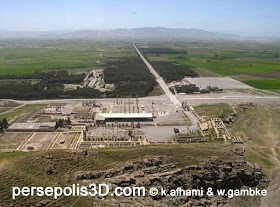It makes me extremely happy to see the recent efforts made in presenting the site of Persepolis. We generally have to do with the image of some lonely gates and columns on a deserted and windy Iranian high plateau, and that’s about it.
My previous find was a wonderful presentation of the site in 360 degrees that helps us walking through the many staterooms and others of this gigantic palace (see: Persepolis in modern technology).
This time, I found even better, a 3D presentation of Persepolis created thanks to the elaborate drawings and scale models made by Friedrich Krefter after his initial excavations in 1933. It is clear that he knows the premises as no other, as he worked together with E. Herzfeld and E.F. Schmidt in those early years of last century. They didn’t have the technology we have now but it is commendable that their work is still contributing to re-create today’s computerized images.
At this stage of the project, we are able to step back in time to the Persian Empire of the 6th century BC but the picture is far from complete and work is still ongoing. Archaeologists still don’t agree whether the plans for this palace were envisioned by Darius the Great or by his son Xerxes, although the preference seems to go to Xerxes.
In this 3D presentation, several locations have been highlighted so far: the Gate of All Nations with its grand stairway; the Throne Hall also known as Hall of One Hundred Columns being the largest building; the Gate of Army that was still under construction when Alexander the Great arrived; the Apadana or Audience Hall, an architectural wonder that surpasses the Temple of Artemis in Ephesus; two Harems or Women’s Quarters, the Royal Treasury, and many others whose function is still under discussion.

No comments:
Post a Comment